Every so often, every gardener gets the urge to try something new and very different. Lavishly illustrated nursery catalogs and garden books as well as trips to the Chicago Botanic Garden feed our hunger to grow the most beautiful plants we can find.
As in all aspects of life, we can’t have everything we see and want. The trees, shrubs, perennials and annuals that we see in books and catalogs are stunningly beautiful because they are growing in the right place, in the right climate and the right soil conditions. Plants that will knock your eyes out in Cape Cod, South Carolina or Oregon may be very disappointing or impossible to grow in the Chicago area.
Good gardeners and professional landscapers are very knowledgeable about which plants do best in a particular location. The ideal plant grown in an ideal environment will give maximum performance, which is what we all want. On the other hand, an overly cautious approach may restrict new plantings to a very short list.
Happily, you don’t have to feel confined. It is possible to select trees and shrubs that are both unusual and will do well in our area’s gardens. These plants are not bizarre oddities. They really deserve to be much more popular, but have been overlooked in favor of more well-known types.
One of the challenges of good garden design is to provide a setting where in such special plants can be noticed and appreciated. These unfamiliar beauties are likely to become your favorites:
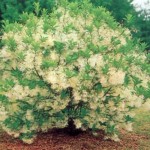 White Fringetree Chionanthus virginicus flowers beautifully for about two weeks in late May or early June. The word “fringe” describes the unusual, long, fine, fleecy and fragrant flowers that hang profusely in clusters called panicles. Its somewhat lustrous green leaves turn yellow in the fall. During September, dark blue berries that attract birds appear amidst the foliage. 12-15′
White Fringetree Chionanthus virginicus flowers beautifully for about two weeks in late May or early June. The word “fringe” describes the unusual, long, fine, fleecy and fragrant flowers that hang profusely in clusters called panicles. Its somewhat lustrous green leaves turn yellow in the fall. During September, dark blue berries that attract birds appear amidst the foliage. 12-15′
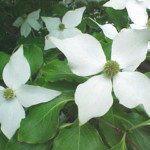 Kousa Dogwood Cornus kousa x florida is another exceptionally beautiful tree in late spring. We think the Rutgers hybrids called ‘Aurora’, ‘Constellation’ and ‘Milky Way’ are some of the best hybrids. The actual flower the Kousa Dogwood bears is small, but the beauty is in the four 1 ½”-2″ creamy white bracts that surround it. The flowers appear in June and last for up to six weeks, rising over the foliage to display their full beauty. The flowering effect can be so dense that very little foliage shows through. Its dark green leaves give a prolonged display of scarlet color in the fall, together with red fruit resembling raspberries. When the tree matures, its bark shows varied colors of gray, tan, and brown as it exfoliates. These hybrids are resistant to the diseases that affect traditional dogwoods. 20-25′
Kousa Dogwood Cornus kousa x florida is another exceptionally beautiful tree in late spring. We think the Rutgers hybrids called ‘Aurora’, ‘Constellation’ and ‘Milky Way’ are some of the best hybrids. The actual flower the Kousa Dogwood bears is small, but the beauty is in the four 1 ½”-2″ creamy white bracts that surround it. The flowers appear in June and last for up to six weeks, rising over the foliage to display their full beauty. The flowering effect can be so dense that very little foliage shows through. Its dark green leaves give a prolonged display of scarlet color in the fall, together with red fruit resembling raspberries. When the tree matures, its bark shows varied colors of gray, tan, and brown as it exfoliates. These hybrids are resistant to the diseases that affect traditional dogwoods. 20-25′
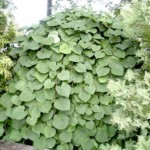 Lavender Twist Redbud Cercis Canadensis ‘Covey’ is an unusual small tree with a weeping habit, contorted branches, bright lavender-pink blooms in early spring that give way to large heart shaped leaves. Small in stature but substantial in impact, it’s the perfect focal point near an entry or by a patio, offering four seasons of interest. 8-10′
Lavender Twist Redbud Cercis Canadensis ‘Covey’ is an unusual small tree with a weeping habit, contorted branches, bright lavender-pink blooms in early spring that give way to large heart shaped leaves. Small in stature but substantial in impact, it’s the perfect focal point near an entry or by a patio, offering four seasons of interest. 8-10′
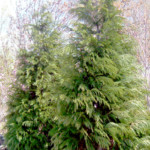 Sullivan Falsecypress Chamaecyparis nootkanensis ‘Sullivan’ is a beautiful pyramidal evergreen that has the special characteristic of shade tolerance. Full but narrow, its leaves are soft to the touch, similar to an Arborvitae, and when in bloom, miniscule seeds on its tips turn a striking red. An excellent alternative to Eastern Hemlock, which often loses foliage and looks leggy with age. 15-20′
Sullivan Falsecypress Chamaecyparis nootkanensis ‘Sullivan’ is a beautiful pyramidal evergreen that has the special characteristic of shade tolerance. Full but narrow, its leaves are soft to the touch, similar to an Arborvitae, and when in bloom, miniscule seeds on its tips turn a striking red. An excellent alternative to Eastern Hemlock, which often loses foliage and looks leggy with age. 15-20′
 Seven Son Flower Tree Heptacodium planatoides is a tough, exotic beauty, a fast-growing, salt-tolerant ornamental tree offering a long bloom period and winter interest. In late summer, its tiered branches bloom with long-lasting white flowers that fade to reveal bright orange-pink calyxes that persist well into fall. Beautiful exfolitating bark offers added interest in winter as well. It can be trained as a tree or a shrub. 15-30′
Seven Son Flower Tree Heptacodium planatoides is a tough, exotic beauty, a fast-growing, salt-tolerant ornamental tree offering a long bloom period and winter interest. In late summer, its tiered branches bloom with long-lasting white flowers that fade to reveal bright orange-pink calyxes that persist well into fall. Beautiful exfolitating bark offers added interest in winter as well. It can be trained as a tree or a shrub. 15-30′
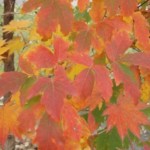 Three-flowered Maple Acer triflorum is another exceptional specimen tree with multi-season interest, especially during the fall, when leaves turn brilliant orange red. When planted in full sun it keeps a compact habit; in shade, a spreading one. 20-25′
Three-flowered Maple Acer triflorum is another exceptional specimen tree with multi-season interest, especially during the fall, when leaves turn brilliant orange red. When planted in full sun it keeps a compact habit; in shade, a spreading one. 20-25′
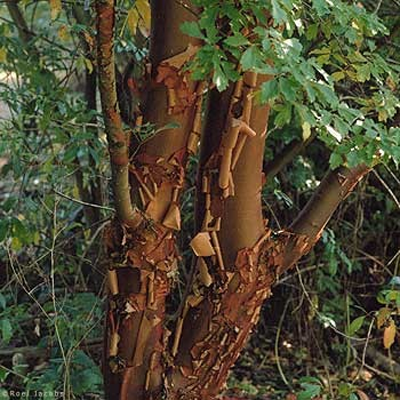 Paperbark Maple Acer Griseum is a slow-growing, small ornamental tree with a lovely round habit. It is noted for its cinnamon colored bark, which exfoliates in thin strips. In fall, leaves turn a beautiful crimson red. Excellent winter interest. 20′
Paperbark Maple Acer Griseum is a slow-growing, small ornamental tree with a lovely round habit. It is noted for its cinnamon colored bark, which exfoliates in thin strips. In fall, leaves turn a beautiful crimson red. Excellent winter interest. 20′
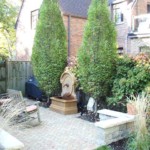 Columnar Hornbeam Carpinus columnaris ‘Frans Fontaine’ is a long-lived, handsome tree with small, glossy, serrated leaves, a strong vertical trunk and a narrow habit (only 5′ wide), making it ideal for screening in tight spaces or acting as a single specimen in a small space. It can be sheared into a hedge or topiary as it is slow-growing. Leaves turn gold in the fall. Full sun to part shade. 20′
Columnar Hornbeam Carpinus columnaris ‘Frans Fontaine’ is a long-lived, handsome tree with small, glossy, serrated leaves, a strong vertical trunk and a narrow habit (only 5′ wide), making it ideal for screening in tight spaces or acting as a single specimen in a small space. It can be sheared into a hedge or topiary as it is slow-growing. Leaves turn gold in the fall. Full sun to part shade. 20′
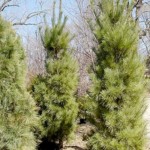 Columnar White Pine Pinus strobus ‘Fastigiata’ is a hardy pine native to the eastern part of the country. Its long, delicate, evergreen needles and narrow habit lend a soft yet stately air to any landscape. Great for screening or as a specimen in tight spaces. Full sun. 20-30′
Columnar White Pine Pinus strobus ‘Fastigiata’ is a hardy pine native to the eastern part of the country. Its long, delicate, evergreen needles and narrow habit lend a soft yet stately air to any landscape. Great for screening or as a specimen in tight spaces. Full sun. 20-30′
 Contorted Filbert Corylus avellana is far from your average garden variety shrub, with its twisting branches and crispy, curly dark green leaves. In early spring it bears weeping yellow flower clusters. In the summer, covered with leaves, it appears shapeless and moplike, but in the fall it sheds its leaves to reveal a dramatic silhouette through winter. 12-15′
Contorted Filbert Corylus avellana is far from your average garden variety shrub, with its twisting branches and crispy, curly dark green leaves. In early spring it bears weeping yellow flower clusters. In the summer, covered with leaves, it appears shapeless and moplike, but in the fall it sheds its leaves to reveal a dramatic silhouette through winter. 12-15′
If you’d like to see these and other plant possibilities, it’s a great time to walk through our nursery at 2000 Greenleaf Street, Evanston. Our knowledgeable staff can answer any questions you may have about selecting something new and different for your garden.
